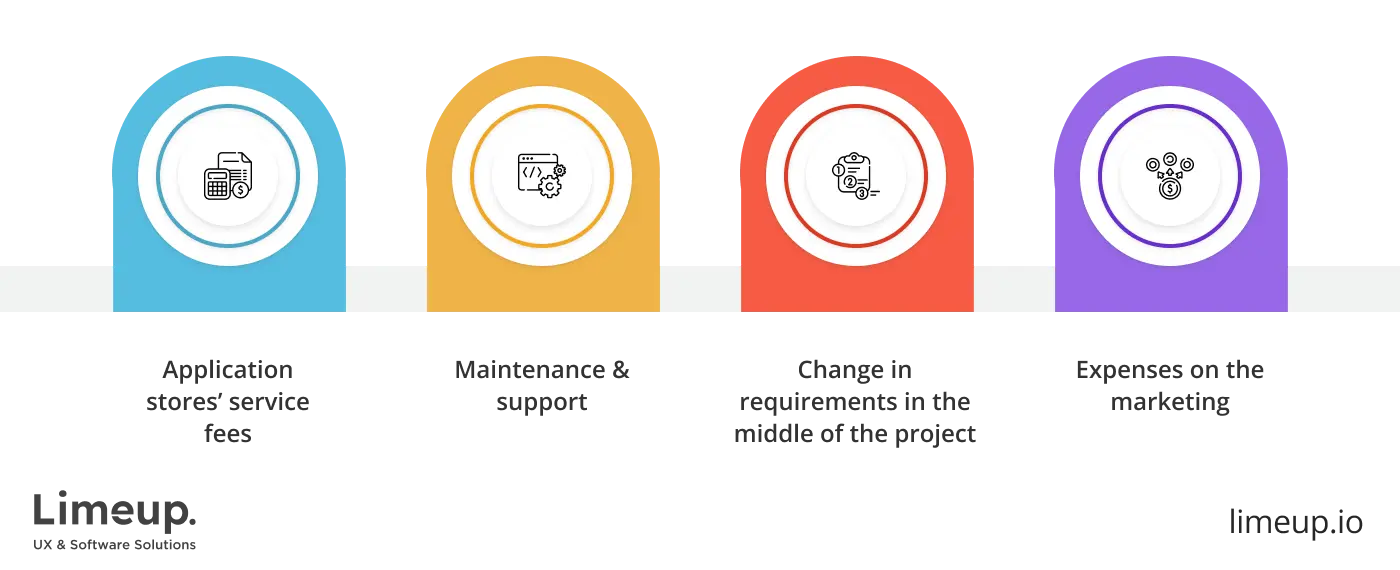App Development Cost: Complete Breakdown

The question of app development cost is always on the table when businesses are looking into creating their own solution as it is going to determine the future path of the project. It’s completely natural to want to know what would the expected price be before jumping into a partnership with vendors in the United Kingdom.
If you have ever wondered how much does it cost to make an app, we come in handy with a comprehensive outline of every nuance that makes up this topic. With the information we are going to provide, you will have a much easier time estimating a realistic budget based on our professional insights.
In this article, we will touch on crucial points such as what influences the cost of app development, the average price ranges by type, assessment methods, hidden fees and much more. Let’s get straight into it.
How much does it cost to make an app: influential factors?
To start off our synopsis, we would like to talk about the specific factors that make up price formation for the creation of the app. Luckily, all of the following points you are capable of controlling whether by the makeup of the solution or by your decision in terms of a vendor. So, what are they exactly?
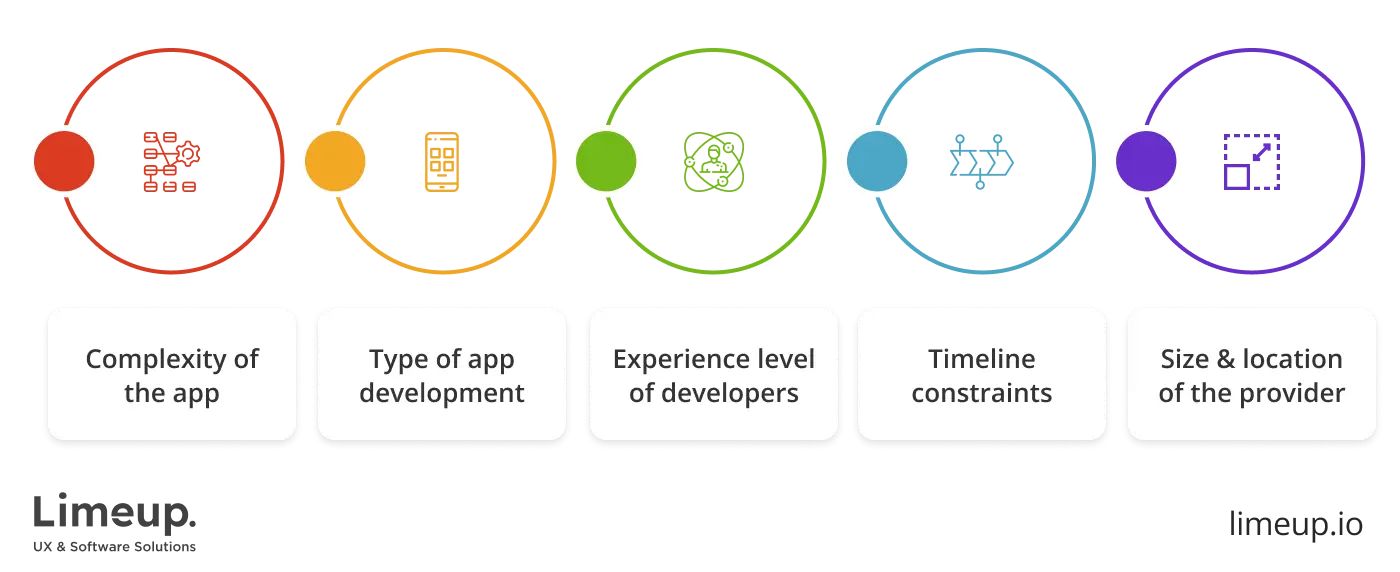
The biggest aspect that will tell you how much your solution will end up costing is its overall complexity and scale. It comes as no surprise that if you want something big and feature-rich, you are going to have to break the bank. The more functionalities and customisation you wish your application to have, the more you are going to pay.
This factor of app development pricing is reflected in both the hours and resources the provider has to spend on your projects as well as in the extent of the expertise such an app will necessitate which will touch on later.
As you may already know, when it comes to mobile solution building, there are two options between which you get to choose: native development and cross-platform. The former refers to a creation process where one set of code is written for either Android or iOS apps using a platform-specific technology stack. In that case your solution will only be usable on one of the two operating systems.
On the other hand, a cross-platform approach allows specialists to reuse one set of code for both OS by utilizing specialised tools. So if you need an app for only one platform, then native will be cheaper, however, if you want the solution to work indiscriminately, then cross-platform development will ultimately be more affordable.
Like we said previously, the level of experience and extent of expertise of the technical experts will inevitably influence the cost for application development. Generally, they are separated into categories such as junior, middle and senior but these are quite subjective and may not entirely reflect on the skill set.
Still, for less complicated solutions with straightforward functionality less experienced specialists will make the cut as their services tend to be on a more affordable side. In case your project is on a complex side and necessitates in-depth expertise, then middle and senior developers become a must and their services are priced accordingly.
It is true that if your application development process naturally calls for shorter deadlines then it is likely to cost more simply by the fact of less work needing to be done. With that being said, if you as a client ask for faster turnaround times even if your solution would typically necessitate an extended timeline, be prepared to pay extra.
This is explained by the need for the professionals to prioritise your project over others and put more resources, such as staff, into finishing the request in shorter periods of time which is not without its accommodations.
The last memorable factor determining the mobile app development price is the size and location of the provider you pick. You have the option to select from the range of large companies and boutique suppliers that charge according to their staff numbers, years on the market and reputation.
On top of that, in large cities like London which are considered global technological hubs, the prices are generally on the higher end compared to smaller cities so be considerate when making that decision as it can further fluctuate your budget expectations.
What is the average cost of app development in the UK?
Coming up with a concrete price for a solution is practically impossible without analysing its requirements and objectives first. As you can already assess, a lot of details fluctuate in the price range leading to discrepancies even between very similar projects.
What we can do, however, is look at some of the common cost ranges provided by app development companies in the UK based on the type of app, its functionality and the average fees of vendors. This can serve you as a very basic app development cost breakdown to give you a headstart on the budget scope, so let’s turn our attention to the table below.
| Type of an app | Functionalities | Average costs |
| Basic apps (calendar, calculator, weather, etc.) | User login, notifications, search bar, etc. | £5,000-£15,000 |
| Medium complexity (photo editor, fitness tracker, messaging, etc.) | Personalisation, advanced search filters, multimedia, etc. | $20,000-£50,000 |
| Advanced (AR, social media, financial, etc.) | AI integrations, natural language processing, cutting-edge security, etc. | £70,000-£150,000 |
| eCommerce | Payment interaction, shopping carts, order and inventory management, etc. | £50,000-£150,000 |
| Enterprise-grade | ERP, workflow automation, real-time analytics, etc. | £100,000-£500,000 |
It is clear to see that prices can vary significantly enough to the point where you can’t even determine on which end of the range you may end up being, let alone pinpoint anything precise. So the best way to get an exact estimation of the development cost is to directly contact a provider and present them with your app idea.
Nonetheless, we are still not done exploring this topic so don’t be upset if you haven’t yet gotten an expected answer to the question, “How much does app development cost?”
To get a full picture of the landscape of the ways prices are formed and how you can better forecast them, there is much more to learn before jumping into reaching out to suppliers. With the information provided further in our brief, you will be able to narrow down the ranges we have discussed above to a more realistic view of your budget.
Methods of estimating app development cost
Wrapping your head around the ways you can estimate your budget at home without the help of specialists by having all the available information about the project at your disposal is not as complicated as it may sound. In fact many others have done it successfully before using a few of the well-known methods of assessment.
Since there is more than one way of calculating a budget for hiring bespoke mobile app development company, we are going to provide you with a summary of the three most effective and beginner-friendly ones.
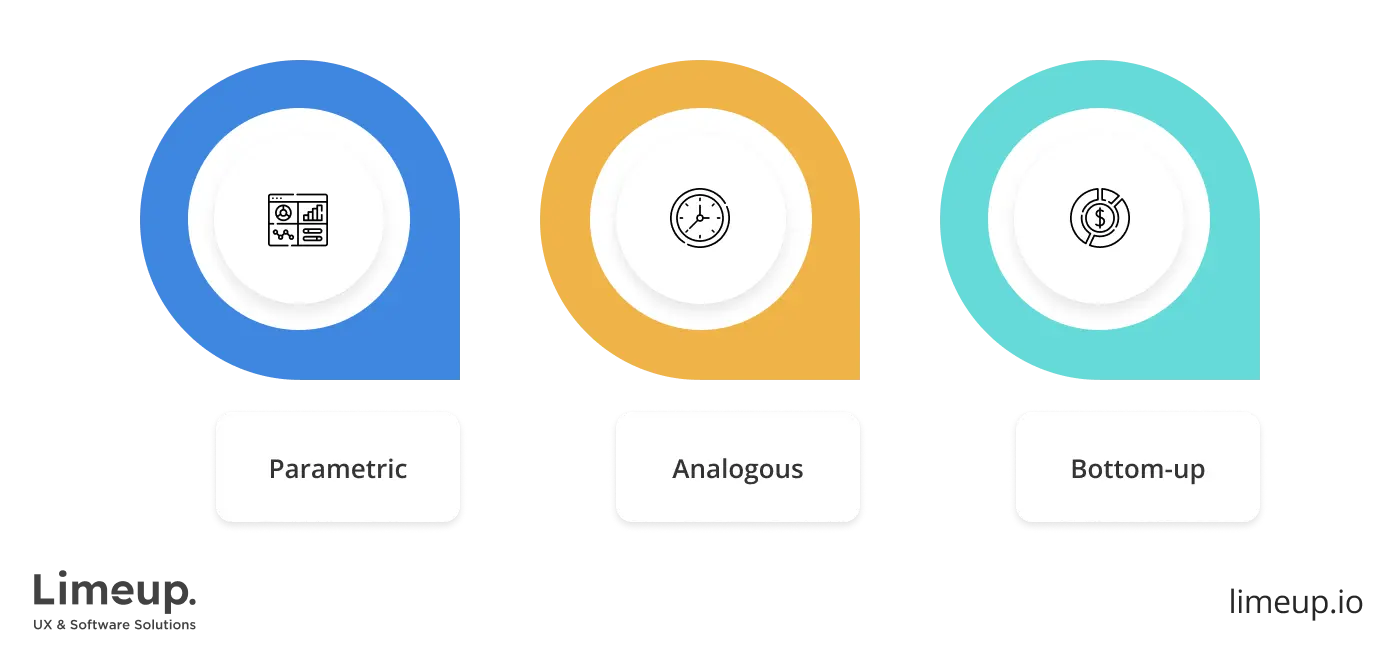
- Parametric
For application creation projects with a thoroughly defined scope of work which includes its number of features, app type, needed expertise according to the complexity, etc., a parametric approach allows for a fairly precise estimation of average app development cost with minimal margin for error if your comprehension of the functionality is wholesome.
What it essentially entails is calculating the scope, including potential work hours required to complete the solution and adding that up to the average charges providers extend for app development. In the end you get a rough budget estimate and it works even better if you already have a vendor in mind and know their pricing.
- Analogous
An analogous method can be a perfect option if you possess information about the cost of projects that are similar to yours, for example, if you have created the solution in the past or someone you know has. That way you can simply compare what the price was for a range of functionalities and the design you would want t see in your own app.
What you should keep in mind is that you have to calculate with an inflation rate in mind if the solution was developed not very recently. Otherwise, if you do not possess that basic knowledge of app price then this method is not going to cut it for you.
- Bottom-up
With a bottom-up app development budget estimation process you are capable of getting the most accurate results while simultaneously spending more time as opposed to other methods. To break it down, you have to separate each stage of the development into separate sprints and calculate how much time and, consequently, money the experts will spend to complete it.
Pinpointing the costs for each stage gives you a more in-depth and precise understanding of the budgetary resources for all the bells and whistles you want. On top of that, the benefit of this method is that you can make calculations for low-end and high-end expenses to get a realistic range but it calls for thorough knowledge of the app development processes.
Depending on the scale of your project and its unique nuances, picking any of these methods can give you a more narrowed-down insight into how much you can expect to spend on your solution.
Mobile app development cost models: hourly rates vs fixed costs
When it comes to cherry-picking which payment model with a development supplier is going to fit your goals the most, there are several options. Keep in mind that not all organisations offer every model under the sun so what you should be aware of right now is the two most widespread options: pay-per-hour or a fixed price fee.
By getting acquainted with the cost of an app development in terms of models, it can further aid your estimation effort as there are pros and cons for each solution. Let’s take a closer look at the table below.
| Pricing model | Hourly rates | Fixed price |
| What it means | You pay for each hour the specialists spend on developing your project based on their pre-defined per-hour fees. | The vendor analyses the scope of work and extends a flat fee for the entire project development and implementation based on the scale of work. |
| What it’s good for | Solutions with fewer complexities, long-term collaboration, projects with fluctuating requirements. | Large and complex applications, short-term partnerships, projects with clearly defined needs. |
As you can see, each of the models is good for some types of projects and not such a good fit for others. How much does mobile app development cost in your case will be better defined after a rigorous analysis of the requirements using the methodologies we have explained in the previous section.
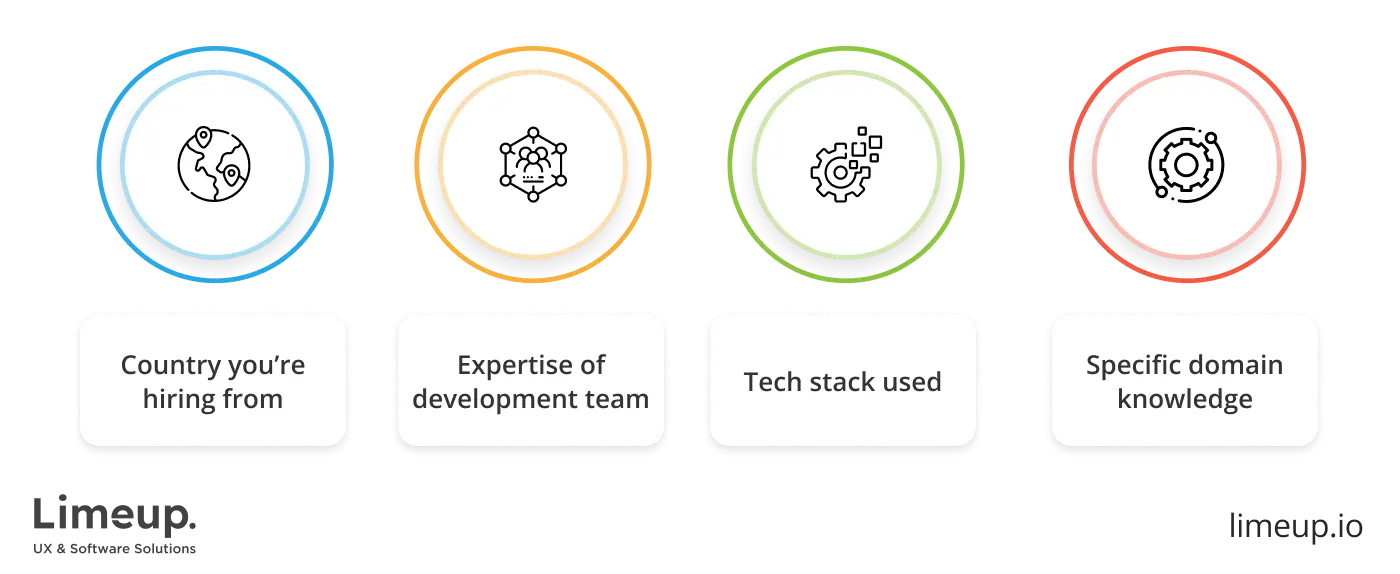
It should be mentioned that some of the other models also include time and materials, subscriptions, retainers, value-based and hybrid options. The last one entails a combination of several payment methods most often by the stages that specialists complete since each phase can be progressed through with different approaches.
All in all, your best bet is to select providers with their available payment solutions in mind to avoid unsuitable agreements.
Suggestions for reducing app development price
The last chapter of our brief we want to expand on in regards to software development cost is giving you some practical tips to help you reduce overhead prices for the creation. We won’t bore you with advice like “pick the best team” because it is a given but rather valuable options to consider to make a difference.
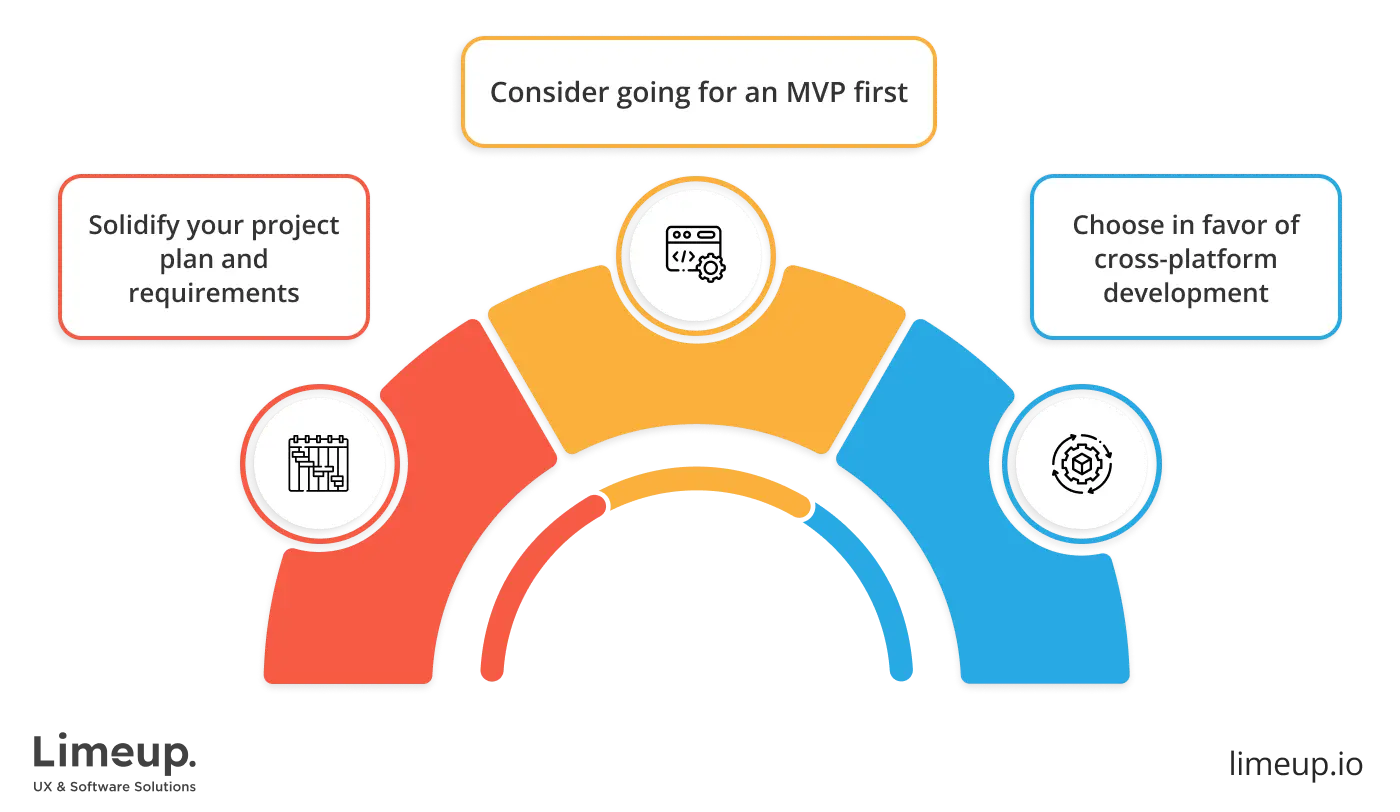
Solidify your project plan and requirements. It may seem like a “Duh!” point that we promised to avoid but in actuality the beginning of the project is a critical time to make decisions that will ultimately affect the price. In what ways? Let’s put this into an example: you decide on an idea for the app but fail to properly plan for it, resulting in changes during the development which, as you know, can spike up the final price.
So one of the best ways to avoid unnecessarily increasing your application development cost is to take precautions and plan the scope from A to Z.
Consider going for an MVP first. A minimum viable product is a masterful way to reduce the initial budget for building an application. What it essentially boils down to is opting for developing only the core features of the solution to test its viability with the real audience and validate that your project is bound to be fruitful.
Crafting only the necessary functionality first substantially lowers the costs of programming at the beginning and enables you to build on features as you go. This is a perfect option for startups with smaller capital to get off on the right foot and enter the market with your product faster.
Choose in favor of cross-platform development. You may think that the cost of mobile app development for a cross-platform solution is more expensive than creating a single-platform app and technically it is. But consider this: if you are rock solid that you only need an application for one operating system, then navite is the way to go.
Yet, what if you are planning to expand to all platforms? The native route may be less pricey originally but you will end up paying twice the amount to build another app. In that case, going all out on cross-platform development will save you a hefty sum which you can later spend on improving and growing your solution in the long run.
Keep these ideas in mind when making crucial decisions in regards to the future of your project and plan your budget accordingly.
Final thoughts
By breaking down the mobile app development cost you are now more aware of every element and nuance that shapes the price of a solution in the modern market. We covered what influences the expense, the average costs, estimation models, hidden fees and much more to empower you to make informed decisions about the ways to go with your project budget.
If you would like to join forces with a seasoned development provider carrying a bulletproof track record, don’t hesitate to reach out to Limeup. Our experts are dedicated to delivering one-of-a-kind applications with transparency and integrity as our core values when collaborating with a client.

